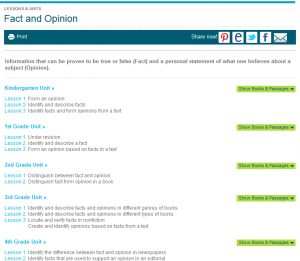Common Core Reading Lessons: Fact and Opinion
 Information that can be proven to be true or false (Fact) and a personal statement of what one believes about a subject (Opinion).
Information that can be proven to be true or false (Fact) and a personal statement of what one believes about a subject (Opinion).
Fact and Opinion - Covers kindergarten through sixth grade. Examples: Identify facts and form opinions from a text. Distinguish between fact and opinion. Locate and verify facts in nonfiction. Create and identify opinions based on facts from a text. Identify facts that are used to support an opinion in an editorial.
Key Ideas and Details
CCSS.ELA-Literacy.RI.K.2 With prompting and support, identify the main topic and retell key details of a text.
Integration of Knowledge and Ideas
CCSS.ELA-Literacy.RI.K.7 With prompting and support, describe the relationship between illustrations and the text in which they appear (e.g., what person, place, thing, or idea in the text an illustration depicts).
CCSS.ELA-Literacy.RI.K.8 With prompting and support, identify the reasons an author gives to support points in a text.
Text Types and Purposes
CCSS.ELA-Literacy.W.K.1 Use a combination of drawing, dictating, and writing to compose opinion pieces in which they tell a reader the topic or the name of the book they are writing about and state an opinion or preference about the topic or book (e.g., My favorite book is . . .).
Key Ideas and Details
CCSS.ELA-Literacy.RI.1.1 Ask and answer questions about key details in a text.
CCSS.ELA-Literacy.RI.1.2 Identify the main topic and retell key details of a text.
Craft and Structure
CCSS.ELA-Literacy.RI.1.6 Distinguish between information provided by pictures or other illustrations and information provided by the words in a text.
Integration of Knowledge and Ideas
CCSS.ELA-Literacy.RI.1.7 Use the illustrations and details in a text to describe its key ideas.
CCSS.ELA-Literacy.RI.1.8 Identify the reasons an author gives to support points in a text.
Key Ideas and Details
CCSS.ELA-Literacy.RI.2.1 Ask and answer such questions as who, what, where, when, why, and how to demonstrate understanding of key details in a text.
CCSS.ELA-Literacy.RI.2.2 Identify the main topic of a multiparagraph text as well as the focus of specific paragraphs within the text.
Craft and Structure
CCSS.ELA-Literacy.RI.2.4 Determine the meaning of words and phrases in a text relevant to a grade 2 topic or subject area.
Integration of Knowledge and Ideas
CCSS.ELA-Literacy.RI.2.8 Describe how reasons support specific points the author makes in a text.
Key Ideas and Details
CCSS.ELA-Literacy.RI.3.1 Ask and answer questions to demonstrate understanding of a text, referring explicitly to the text as the basis for the answers.
CCSS.ELA-Literacy.RI.3.2 Determine the main idea of a text; recount the key details and explain how they support the main idea.
Text Types and Purposes
CCSS.ELA-Literacy.W.3.1 Write opinion pieces on topics or texts, supporting a point of view with reasons.
CCSS.ELA-Literacy.W.3.1a Introduce the topic or text they are writing about, state an opinion, and create an organizational structure that lists reasons.
CCSS.ELA-Literacy.W.3.1b Provide reasons that support the opinion.
CCSS.ELA-Literacy.W.3.1c Use linking words and phrases (e.g., because, therefore, since, for example) to connect opinion and reasons.
Comprehension and Collaboration
CCSS.ELA-Literacy.SL.3.2 Determine the main ideas and supporting details of a text read aloud or information presented in diverse media and formats, including visually, quantitatively, and orally.
Key Ideas and Details
CCSS.ELA-Literacy.RI.4.1 Refer to details and examples in a text when explaining what the text says explicitly and when drawing inferences from the text.
CCSS.ELA-Literacy.RI.4.2 Determine the main idea of a text and explain how it is supported by key details; summarize the text.
CCSS.ELA-Literacy.RI.4.3 Explain events, procedures, ideas, or concepts in a historical, scientific, or technical text, including what happened and why, based on specific information in the text.
Craft and Structure
CCSS.ELA-Literacy.RI.4.4 Determine the meaning of general academic and domain-specific words or phrases in a text relevant to a grade 4 topic or subject area.
Integration of Knowledge and Ideas
CCSS.ELA-Literacy.RI.4.8 Explain how an author uses reasons and evidence to support particular points in a text.
Range of Reading and Level of Text Complexity
CCSS.ELA-Literacy.RI.4.10 By the end of year, read and comprehend informational texts, including history/social studies, science, and technical texts, in the grades 4-5 text complexity band proficiently, with scaffolding as needed at the high end of the range.
Research to Build and Present Knowledge
CCSS.ELA-Literacy.W.4.8 Recall relevant information from experiences or gather relevant information from print and digital sources; take notes and categorize information, and provide a list of sources.
Conventions of Standard English
CCSS.ELA-Literacy.L.4.1 Demonstrate command of the conventions of standard English grammar and usage when writing or speaking.
CCSS.ELA-Literacy.L.4.1f Produce complete sentences, recognizing and correcting inappropriate fragments and run-ons.
Vocabulary Acquisition and Use
CCSS.ELA-Literacy.L.4.4 Determine or clarify the meaning of unknown and multiple-meaning words and phrases based on grade 4 reading and content, choosing flexibly from a range of strategies.
CCSS.ELA-Literacy.L.4.4a Use context (e.g., definitions, examples, or restatements in text) as a clue to the meaning of a word or phrase.
CCSS.ELA-Literacy.L.4.6 Acquire and use accurately grade-appropriate general academic and domain-specific words and phrases, including those that signal precise actions, emotions, or states of being (e.g., quizzed, whined, stammered) and that are basic to a particular topic (e.g., wildlife, conservation, and endangered when discussing animal preservation).